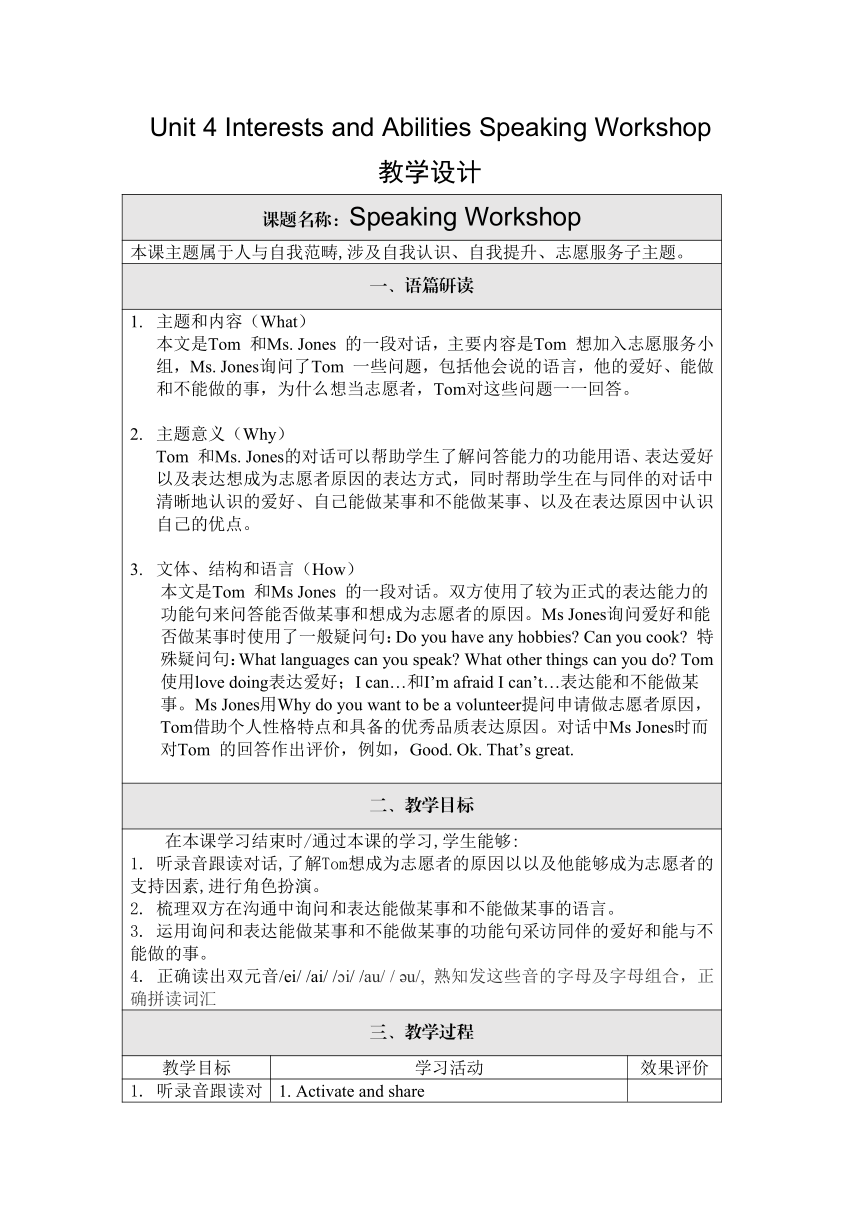Unit 4 Interests and Abilities Speaking Workshop 教案(表格式)2024-2025学年(北师大版)英语七年级上册
文档属性
| 名称 | Unit 4 Interests and Abilities Speaking Workshop 教案(表格式)2024-2025学年(北师大版)英语七年级上册 |  | |
| 格式 | docx | ||
| 文件大小 | 258.5KB | ||
| 资源类型 | 教案 | ||
| 版本资源 | 北师大版 | ||
| 科目 | 英语 | ||
| 更新时间 | 2025-01-12 14:07:02 | ||
图片预览

文档简介
Unit 4 Interests and Abilities Speaking Workshop
教学设计
课题名称:Speaking Workshop
本课主题属于人与自我范畴,涉及自我认识、自我提升、志愿服务子主题。
一、语篇研读
主题和内容(What) 本文是Tom 和Ms. Jones 的一段对话,主要内容是Tom 想加入志愿服务小组,Ms. Jones询问了Tom 一些问题,包括他会说的语言,他的爱好、能做和不能做的事,为什么想当志愿者,Tom对这些问题一一回答。 主题意义(Why) Tom 和Ms. Jones的对话可以帮助学生了解问答能力的功能用语、表达爱好以及表达想成为志愿者原因的表达方式,同时帮助学生在与同伴的对话中清晰地认识的爱好、自己能做某事和不能做某事、以及在表达原因中认识自己的优点。 文体、结构和语言(How) 本文是Tom 和Ms Jones 的一段对话。双方使用了较为正式的表达能力的功能句来问答能否做某事和想成为志愿者的原因。Ms Jones询问爱好和能否做某事时使用了一般疑问句:Do you have any hobbies Can you cook 特殊疑问句:What languages can you speak What other things can you do Tom使用love doing表达爱好;I can…和I’m afraid I can’t…表达能和不能做某事。Ms Jones用Why do you want to be a volunteer提问申请做志愿者原因,Tom借助个人性格特点和具备的优秀品质表达原因。对话中Ms Jones时而对Tom 的回答作出评价,例如,Good. Ok. That’s great.
二、教学目标
在本课学习结束时/通过本课的学习,学生能够: 1. 听录音跟读对话,了解Tom想成为志愿者的原因以以及他能够成为志愿者的支持因素,进行角色扮演。 2. 梳理双方在沟通中询问和表达能做某事和不能做某事的语言。 3. 运用询问和表达能做某事和不能做某事的功能句采访同伴的爱好和能与不能做的事。 4. 正确读出双元音/ei/ /ai/ / i/ /au/ / u/, 熟知发这些音的字母及字母组合,正确拼读词汇
三、教学过程
教学目标 学习活动 效果评价
1. 听录音跟读对话,了解Tom想成为志愿者的原因以以及他能够成为志愿者的支持因素,进行角色扮演。 1. Activate and share T: You are helping your classmates to choose after-school clubs. What questions can you ask Talk with a partner. Qs: What are you interested in What’s your hobby? Do you like doing sports Can you play any instrument What sports can you do ...... 2.Listen and read T: Tom wants to join a volunteer group. Now he is talking with Ms Jones. Let’s listen to the dialogue. What questions does Ms Jones ask Listen and focus on the questions Ms Jones asks. Listen to the dialogue and underline the key information for the questions: What things can Tom do Why does he want to be a volunteer? Listen and repeat the dialogue. Role -play the dialogue. 观察学生能否说出询问他人爱好、能否做某事的问题,并给予引导。 学生能否正确找出Tom表达他能做某事和想当志愿者的原因。 观察学生能否模仿对话,正确朗读对话。
设计意图:在真实情境中引发学生对询问爱好和能力的功能句的关注;在对话中引起学生对表达爱好、能做某事与否、表达成为志愿者原因的句子的注意;在听和跟读、角色扮演中内化语言表达、练习语音语调。
2.梳理双方在沟通中询问和表达能做某事和不能做某事的语言。 3. Read and learn ①T: Read the dialogue again. Q: How do they express ability and inability ② Listen and complete the Talk Builder. ③Repeat the sentences in the Talk Builder. 观察学生是否能正确补全句子,提炼总结出询问和回答表达能力的功能句。
设计意图: 引导学生梳理询问和表达能做某事和不能做某事的语言表达方式,为在真实情境中运用所学做好铺垫。
3.运用询问和表达能做某事和不能做某事的功能句采访同伴的爱好和能与不能做的事。 4. Speaking T: Interview a partner about his or her abilities and hobbies. Use the sentences in the Talk Builder to help you. ① Students work in pairs ② Tell to the class. 观察学生在与同伴交流中能否正确使用功能句问答,语音语调是否正确。
设计意图: 在真实情境中运用表达爱好和能力的功能句进行真实交际。
4.正确读出双元音/ei/ /ai// i/ /au/ / u/, 熟知发这些音的字母及字母组合,正确拼读词汇. 5. Pronunciation ① Listen and repeat. ② Read and circle the word with the phonetic sound that doesn’t match. ③ Identify the underlined phonetic sounds in Activity 1. Which sound appears in both the poems and the quotation ④ Read and underline the phonetic sounds in Activity 1. ⑤Look at the phonetic symbols below. How do you spell the words 观察学生是否能够正确朗读单词,并能够在词汇中识别出这五个双元音的发音和字母组合。能否认读音标,正确拼出单词。
五、作业
朗读对话。 朗读语音练习中的单词和句子。
六、教学反思
学生有意识并基本能结合单元主题内容,爱好和能力方面的提问来帮助他人选择俱乐部,能对兴趣爱好和能力进行简单的交流和运用。语音只是对已基础较弱的孩子来说有点困难,他们能基本正确地读出单词,但识别音标能力较弱。
教学设计
课题名称:Speaking Workshop
本课主题属于人与自我范畴,涉及自我认识、自我提升、志愿服务子主题。
一、语篇研读
主题和内容(What) 本文是Tom 和Ms. Jones 的一段对话,主要内容是Tom 想加入志愿服务小组,Ms. Jones询问了Tom 一些问题,包括他会说的语言,他的爱好、能做和不能做的事,为什么想当志愿者,Tom对这些问题一一回答。 主题意义(Why) Tom 和Ms. Jones的对话可以帮助学生了解问答能力的功能用语、表达爱好以及表达想成为志愿者原因的表达方式,同时帮助学生在与同伴的对话中清晰地认识的爱好、自己能做某事和不能做某事、以及在表达原因中认识自己的优点。 文体、结构和语言(How) 本文是Tom 和Ms Jones 的一段对话。双方使用了较为正式的表达能力的功能句来问答能否做某事和想成为志愿者的原因。Ms Jones询问爱好和能否做某事时使用了一般疑问句:Do you have any hobbies Can you cook 特殊疑问句:What languages can you speak What other things can you do Tom使用love doing表达爱好;I can…和I’m afraid I can’t…表达能和不能做某事。Ms Jones用Why do you want to be a volunteer提问申请做志愿者原因,Tom借助个人性格特点和具备的优秀品质表达原因。对话中Ms Jones时而对Tom 的回答作出评价,例如,Good. Ok. That’s great.
二、教学目标
在本课学习结束时/通过本课的学习,学生能够: 1. 听录音跟读对话,了解Tom想成为志愿者的原因以以及他能够成为志愿者的支持因素,进行角色扮演。 2. 梳理双方在沟通中询问和表达能做某事和不能做某事的语言。 3. 运用询问和表达能做某事和不能做某事的功能句采访同伴的爱好和能与不能做的事。 4. 正确读出双元音/ei/ /ai/ / i/ /au/ / u/, 熟知发这些音的字母及字母组合,正确拼读词汇
三、教学过程
教学目标 学习活动 效果评价
1. 听录音跟读对话,了解Tom想成为志愿者的原因以以及他能够成为志愿者的支持因素,进行角色扮演。 1. Activate and share T: You are helping your classmates to choose after-school clubs. What questions can you ask Talk with a partner. Qs: What are you interested in What’s your hobby? Do you like doing sports Can you play any instrument What sports can you do ...... 2.Listen and read T: Tom wants to join a volunteer group. Now he is talking with Ms Jones. Let’s listen to the dialogue. What questions does Ms Jones ask Listen and focus on the questions Ms Jones asks. Listen to the dialogue and underline the key information for the questions: What things can Tom do Why does he want to be a volunteer? Listen and repeat the dialogue. Role -play the dialogue. 观察学生能否说出询问他人爱好、能否做某事的问题,并给予引导。 学生能否正确找出Tom表达他能做某事和想当志愿者的原因。 观察学生能否模仿对话,正确朗读对话。
设计意图:在真实情境中引发学生对询问爱好和能力的功能句的关注;在对话中引起学生对表达爱好、能做某事与否、表达成为志愿者原因的句子的注意;在听和跟读、角色扮演中内化语言表达、练习语音语调。
2.梳理双方在沟通中询问和表达能做某事和不能做某事的语言。 3. Read and learn ①T: Read the dialogue again. Q: How do they express ability and inability ② Listen and complete the Talk Builder. ③Repeat the sentences in the Talk Builder. 观察学生是否能正确补全句子,提炼总结出询问和回答表达能力的功能句。
设计意图: 引导学生梳理询问和表达能做某事和不能做某事的语言表达方式,为在真实情境中运用所学做好铺垫。
3.运用询问和表达能做某事和不能做某事的功能句采访同伴的爱好和能与不能做的事。 4. Speaking T: Interview a partner about his or her abilities and hobbies. Use the sentences in the Talk Builder to help you. ① Students work in pairs ② Tell to the class. 观察学生在与同伴交流中能否正确使用功能句问答,语音语调是否正确。
设计意图: 在真实情境中运用表达爱好和能力的功能句进行真实交际。
4.正确读出双元音/ei/ /ai// i/ /au/ / u/, 熟知发这些音的字母及字母组合,正确拼读词汇. 5. Pronunciation ① Listen and repeat. ② Read and circle the word with the phonetic sound that doesn’t match. ③ Identify the underlined phonetic sounds in Activity 1. Which sound appears in both the poems and the quotation ④ Read and underline the phonetic sounds in Activity 1. ⑤Look at the phonetic symbols below. How do you spell the words 观察学生是否能够正确朗读单词,并能够在词汇中识别出这五个双元音的发音和字母组合。能否认读音标,正确拼出单词。
五、作业
朗读对话。 朗读语音练习中的单词和句子。
六、教学反思
学生有意识并基本能结合单元主题内容,爱好和能力方面的提问来帮助他人选择俱乐部,能对兴趣爱好和能力进行简单的交流和运用。语音只是对已基础较弱的孩子来说有点困难,他们能基本正确地读出单词,但识别音标能力较弱。
同课章节目录
